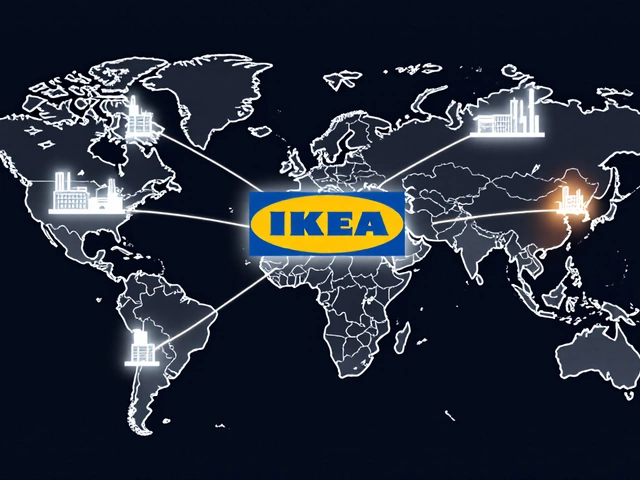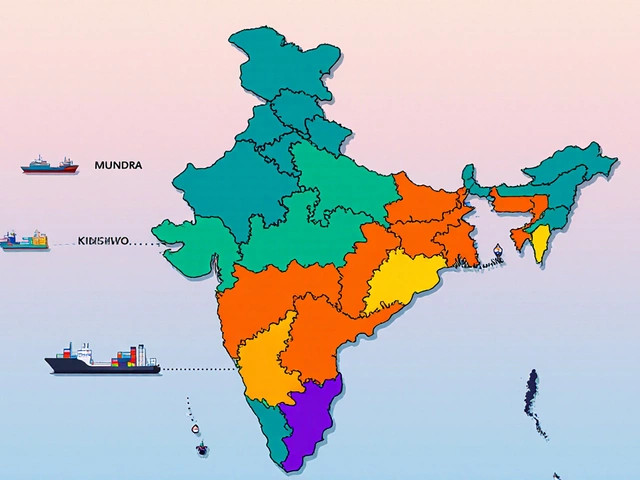Ever wondered why some small manufacturing businesses just take off while others barely crawl along? The secret usually boils down to making stuff that people constantly want to buy. Sounds simple, but get this wrong and you're stuck with piles of unsold stock.
If you're thinking about starting or growing a small manufacturing business, you don't need a fancy factory. You just need to tap into what people actually need and want—right now, not last year. Did you know that reusable packaging, health products, and phone accessories are moving faster than most other goods in 2025?
People aren't buying for the same reasons they did even two years ago. The market's always shifting, so last decade's "sure thing"—like plastic straws, for example—is out, while things like compostable tableware are in. It's not just food and beauty products flying off the shelves either; tech accessories and hardware kits are huge. Focus on everyday wear-and-tear items or products that offer savings, convenience, or a green touch. That's what keeps cash flowing in small manufacturing these days.
- Hot-Selling Daily Use Products
- Rising Trends: Eco-Friendly and Health Goods
- Tech & Gadget Accessories
- Tips to Choose Your Niche in Manufacturing
Hot-Selling Daily Use Products
If you’re eyeing small scale manufacturing that’s steady all year, it’s smart to look at stuff people use almost daily. Think about essentials that run out, wear out, or just make life easier. These products manage to move even when times are tough, because everyone still needs them.
Here are some of the in demand products you’ll see selling fast in 2025:
- Household cleaning products: Safe disinfectants, laundry powders, liquid soaps, and floor cleaners are staples in almost every home. Bigger brands dominate the shelves, but there’s still demand for locally-made or eco-friendly options in smaller packs.
- Reusable water bottles and containers: With single-use plastics declining, there’s a spike in demand for stainless steel, glass, and BPA-free plastic bottles. Personalized prints or custom colors make these an easy win for small batch makers.
- Incense sticks and candles: These might sound old-school, but they’re steady sellers, especially if you have a unique scent or eco twist.
- Personal care items: Handmade soaps, shampoos, and herbal toothpaste fly off the shelf in both cities and smaller towns. It’s even better if you use natural ingredients – customers really search for this now.
- Packaging material: Small businesses popping up online need boxes, bags, and bubble wraps. If you can make sturdy or custom-printed versions, you’ll never run out of buyers.
Check out how these top products line up based on demand and growth for this year:
| Product Category | 2025 Demand Level | Growth Rate (Estimated) |
|---|---|---|
| Household Cleaning Products | Very High | 7% YOY |
| Reusable Bottles/Containers | High | 8% YOY |
| Personal Care Items | High | 10% YOY |
| Incense/Candles | Stable | 3% YOY |
| Packaging Material | Very High | 12% YOY |
Here’s one more thing to keep in mind: don’t just focus on the big buzz. Look around your neighborhood or check what’s missing at local stores. It’s surprising how small tweaks—like different scents, better packaging, or targeting a local tradition—make a product a hit. Starting with these profitable manufacturing staples is a safe way to break in, especially if you’re testing the waters or running things out of a small workshop.
Rising Trends: Eco-Friendly and Health Goods
Eco-friendly and health-focused small scale manufacturing products aren’t just popular—they’re dominating market demand. People are ditching single-use plastics and cheap, chemical-heavy goods. Brands popping up with sustainable habits are cleaning up, from reusable bags to all-natural cleaning supplies. If you’re wondering where the money is flowing, check out these real-world bestsellers:
- Compostable tableware and packaging: Restaurants, home cooks, and delivery services all want plates, cups, and boxes that break down fast and don’t clog up landfills.
- Bamboo toothbrushes and personal care: Simple swap for plastic, but the demand is massive, especially in urban and semi-urban areas.
- Natural cleaning products: Think soaps, surface sprays, and detergents made from plant-based ingredients. Shoppers are looking for non-toxic labels and recognisable ingredients.
- Home fitness gear: Resistance bands, yoga mats made from organic materials, and simple at-home gym kits. After the pandemic, health and fitness is a daily focus for folks working from home.
- Reusable sanitary products: Cloth pads and menstrual cups are gaining popularity for both their eco benefits and cost savings over time.
Here’s a quick look at growth numbers for some of these products in 2024:
| Product Type | Yearly Growth Rate (2024) |
|---|---|
| Compostable Packaging | +22% |
| Natural Cleaning Supplies | +18% |
| Reusable Sanitary Products | +27% |
| Home Fitness Gear | +14% |
Want tips for breaking in? Keep costs lean by starting local, like supplying to small grocery stores or community gyms. Get certification or eco-labels if possible—it boosts trust. Also, listen to feedback: People care about small details, like scent in natural cleaners or comfort of eco-friendly yoga mats.
If you focus on health and eco-friendliness, you’ll attract shoppers who are willing to pay a bit more. Just be honest in your claims and make sure your story backs it up. That trust will set you apart from cheap imitators in the in demand products space.

Tech & Gadget Accessories
If you're searching for high-demand stuff in small scale manufacturing, tech and gadget accessories are as hot as ever in 2025. No surprise there—everyone's glued to their phone, tablet, or laptop these days. But here's the thing: People want accessories that are both functional and cool-looking. They're tired of generic, dull cases and cables. If you can put a twist on a common item, you're on the right track.
For example, wireless earbuds cases in bright or custom colors are flying off online shelves. Add some waterproofing or a hook for bags, and you're looking at a bestseller. Screen protectors, especially those with blue-light filtering or privacy features, are also seeing a big uptick because of all-day device use for work and school.
Here's a quick rundown of accessories seeing serious demand right now:
- Customizable phone cases (think eco-materials, photo printing, unique designs)
- Charging cables with multiple connectors (USB-C/Lightning/Micro-USB in one)
- Reusable cable organizers (magnetic, silicone clips, wrap bands)
- Portable device stands for video calls, gaming or live streaming
- Smartwatch straps and covers, especially in bold colors or sweat-proof materials
And it's not just about looking good—people want stuff that lasts. Accessories made from recycled plastic, flexible silicone, and plant-based materials are booming. If you can put the word "eco-friendly" or "sustainable" on your packaging and mean it, that's a strong selling point in this category.
Check out this quick snapshot of what's trending (based on 2025 Shopify gadget store stats):
| Accessory Type | Growth (Jan–Apr 2025) |
|---|---|
| Custom Phone Cases | +32% |
| Multi-Connector Cables | +27% |
| Eco-Friendly Accessories | +40% |
If you want to start or expand a small scale manufacturing business, you don't need to invent a brand new product. Just upgrade a classic: a charging cable that lasts longer, a watch strap that's sweatproof, a stand that folds flat for travel. Listen to customer reviews online—they'll tell you what they wish was better. Tweak, improve, and offer quick shipping. That's what keeps your accessories flying off the digital shelves in 2025.
Tips to Choose Your Niche in Manufacturing
So you want to break into small scale manufacturing, but choosing what to make feels like rolling dice? Here’s a straightforward plan to help you pick a small scale manufacturing niche that actually makes sense for 2025.
- Spot Consistent Demand: Start by looking for in demand products that people buy all the time—think reusable water bottles, eco-friendly bags, basic kitchen items, masks, or phone accessories. Stuff that gets used up or lost ends up being reordered.
- Check Trends Locally and Globally: Don’t just follow global news. What’s hot in your city or state? For example, some regions have a huge need for affordable solar lamps or recycled building materials for home repairs—the kind of profitable manufacturing ideas that deliver steady business.
- Test Your Skills: Play to your strengths. Got experience with electronics? Phone chargers or small tool kits could work. Good with textiles? Reusable grocery bags, aprons, or PPE kits are options. Choose what you can actually make well without a massive learning curve.
- Dig Into Margins: Check your costs against selling prices. Cheap, bulky items often mean low profits, while compact, high-use goods—like health supplements or gadget accessories—offer better returns per unit of effort.
- Size Up the Competition: Use marketplaces like Amazon, Flipkart, or even your local shops to see what’s crowded and what’s open. If local sellers already flood the market with plastic containers, maybe pivot to bamboo or steel alternatives.
Here’s a quick snapshot of popular trending products in 2025 that show promise on sales platforms and in offline stores:
| Product Type | Demand Level | Main Buyer Group |
|---|---|---|
| Eco-friendly packaging | Very High | Food startups, retailers |
| Phone cases & accessories | High | Tech users, students |
| Reusable kitchenware | High | Families, eco-conscious |
| Home fitness kits | Moderate | Young adults, gyms |
The real trick? Start small and listen to early buyers. Collect feedback, tweak your product, and don’t invest huge cash until you see actual sales. The most profitable manufacturing businesses usually come from finding a simple niche and sticking with it before expanding.









